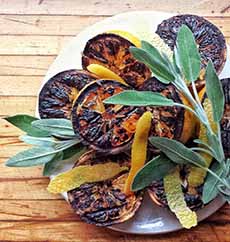Cara Cara Oranges, The “Red Navel” Orange
|
We’d read about Cara Cara oranges, we’d seen photos; but we hadn’t tasted one until this week. It was exquisite: sweet and “old school,” when all fruit was grown to be perfectly sweet and lush. (Today, too much fruit is grown to look great on the shelf, to be durable for transport, to eliminate bothersome seeds, and just about every reason other than natural sweetness and deep taste.) Cara Cara oranges are a variety of navel orange, distinguished by their rosy pink, juicy, sweet flesh and low acidity. The rosy flesh has a berry-flavored zing with a touch of spice. Depending on where the oranges are grown, the undertones can be cherry, cranberry, raspberry, strawberry or a combination. Cara Caras are not unlike like blood oranges, which are grown in the U.S. but hail from Italy, where they also were a natural mutation. As with blood oranges, some have a pink blush outside on the peel, as well as in the flesh. Cara Caras are also called “pink navel” or “red navel” oranges. The Cara Cara variety was first discovered in 1976 on a Washington navel orange tree growing at the Hacienda Cara Cara, a private home in Valencia, Venezuela. It is believed to have been a mutation. The delightful “new” orange was propagated. It has since been crossed with the Bahia navel orange and bred to remove the seeds, which increases consumer appeal. The variety was first planted in Florida groves. Twelve years ago, commercial growing began in California, where the variety thrived in the climate of the San Joaquin Valley. The trees bear fruit from December through April. Cara Caras did not enter the national consumer market until the late 1980s. For years, they were carried only by specialty markets. The fruit was finally distributed nationally about 10 years ago by produce companies like Melissa’s Produce and Sunkist. They are now available at a broader range of grocers nationwide. |
|
|
 A delicious halibut dish with Cara Cara oranges and beets (recipe). Photo courtesy Tasty-Trials.com |
CARA CARA ORANGES ARE MORE NUTRITIOUS As a bonus, Cara Caras deliver more vitamin power. The Sunkist Nutrition Bureau found a wealth of nutritional advantages in Cara Cara oranges: higher in vitamin C, A and fiber than other navels. Sunkist calls its Cara Cara “The Power Orange,” and has trademarked the term. Like other oranges, Cara Caras are a good source of folate and potassium, and the rosy flesh provides Lycopene, the disease-fighting antioxidant found in red-fleshed fruits from papaya to tomato to watermelon. First and foremost, Cara Caras are a wonderful hand fruit:* very juicy and sweet. You can enjoy them at breakfast, snack time or on the run. |
|
|
Look for Cara Cara oranges that are firm and heavy for their size. The juiciest, sweetest fruit will have a sweet, clean fragrance rising from the peel. If you won’t eat all of them immediately, store the oranges in a cool spot for up to one week or refrigerate for up to two weeks. Cara Caras are popular with chefs for use in vinaigrettes and cooked sauces. They pair beautifully with white-fleshed fish such as halibut, and also make a terrific orange sorbet. Here’s a delicious recipe for Halibut with Cara Cara Orange Miso Cream Sauce and Roasted Beets Check out these recipes from Sunkist: There are two major species of eating oranges: Navel and Valencia (bitter orange varieties, such as the Seville, are used in marmalade and other recipes but not as hand fruit.) There are also “minor” varieties in limited supply, such as blood oranges. *The term “hand fruit” refers to a piece of fruit that is eaten from the hand, whether or not it needs to be peeled: apples, bananas, stone fruit (apricots, peaches, pears, plums) and so forth. Even though they can be eaten with the fingers, berries are not hand fruits.
|
||




